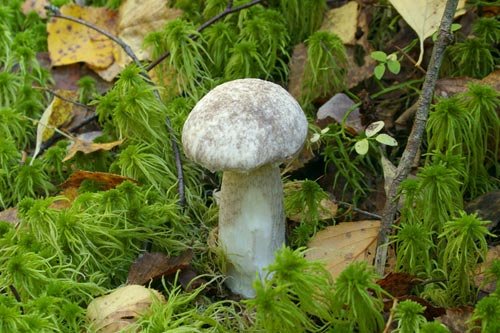Boletus multi-colored (Leccinum variicolor)
- Vaega: Basidiomycota (Basidiomycetes)
- Vaevaega: Agaricomycotina (Agaricomycetes)
- Vasega: Agaricomycetes (Agaricomycetes)
- Vasega laiti: Agaricomycetidae (Agaricomycetes)
- Poloaiga: Boletales (Boletales)
- Aiga: Boletaceae (Boletaceae)
- Genus: Leccinum (Obabok)
- ituaiga: Leccinum variicolor (Boletus varicolour)

Ua:
The boletus has a multi-colored hat of a characteristic gray-whitish mouse color, painted with peculiar “strokes”; diameter – approximately from 7 to 12 cm, shape from hemispherical, closed, to cushion-shaped, slightly convex; the mushroom is generally more “compact” than the common boletus, although not always. The flesh of the cap is white, slightly turning pink on the cut, with a slight pleasant smell.
La'au fa'aola:
The tubes are finely porous, light gray in young mushrooms, becoming gray-brown with age, often covered with darker spots; when pressed, it can also turn pink (or maybe, apparently, not turn pink).
Spora pauta:
Malamalama enaena.
Vaʻa:
10-15 cm in height and 2-3 cm in thickness (the height of the stem depends on the height of the moss above which it is necessary to raise the cap), cylindrical, somewhat thickening in the lower part, white, densely covered with black or dark brown streaked scales. The flesh of the stem is white, in older mushrooms it is strongly fibrous, being cut off at the base, it turns slightly blue.
Faʻasalalau:
The multi-colored boletus bears fruit, like its common counterpart, from the beginning of summer to the end of October, forming mycorrhiza mainly with birch; found mainly in swampy areas, in mosses. In our area, it is relatively rare, you will see it infrequently, and in southern Our Country, judging by the stories of eyewitnesses, it is quite an ordinary mushroom.
Ituaiga tutusa:
It is difficult to understand boletus trees. The boletus themselves cannot do this. We will assume that the varicolored boletus differs from other representatives of the genus Leccinum in the streaked color of the cap and slightly pinkish flesh. There is, however, a pinking boletus (Leccinum oxydabile), which in this case is not clear what to do with, there is a completely white Leccinum holopus. Distinguishing boletus is not so much a scientific issue as an aesthetic one, and this must be remembered in order to find consolation on occasion.
Mea'ai:
Good mushroom, on a level with common boletus.









